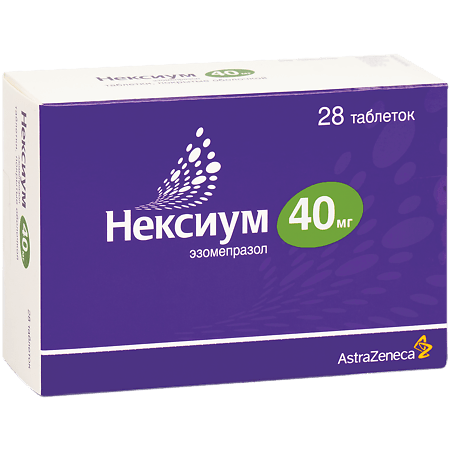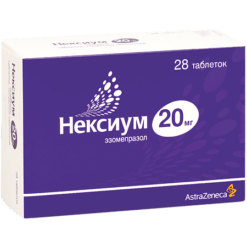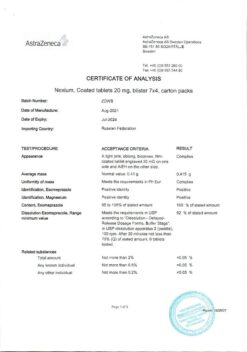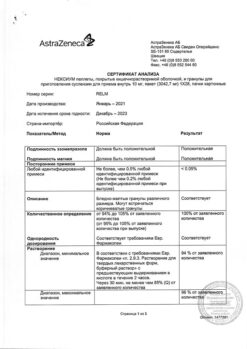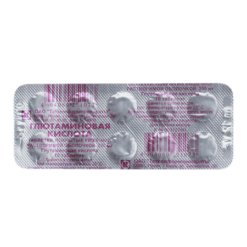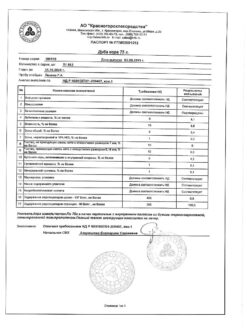No products in the cart.
Nexium, 40 mg 28 pcs.
€13.90 €11.58
EAN: 5000456034319
SKU: 205400
Categories: Medicine, Stomach, intestines, liver, Ulcer and gastritis
Description
Pharmacotherapeutic group: Gastric gland secretion reducing agent – proton pump inhibitor
ATX code: A02BC05
Pharmacological properties Pharmacodynamics Esomeprazole is a S-isomer of omeprazole and reduces hydrochloric acid secretion in the stomach by specifically inhibiting the proton pump in the parietal cells of the stomach. The S– and R-isomer of omeprazole have similar pharmacodynamic activity.
Indications
Indications
Gastroesophageal reflux disease
• treatment of erosive reflux esophagitis
• long-term maintenance treatment after healing of erosive reflux esophagitis to prevent relapse
• symptomatic treatment of gastroesophageal reflux disease
Peptic ulcer of the stomach and duodenum. As part of combination therapy
• treatment of duodenal ulcer associated with Helicobacter pylori
• prevention of relapses of peptic ulcers associated with Helicobacter pylori
Long-term acid suppression therapy in patients who have suffered bleeding from a peptic ulcer (after intravenous use of drugs that reduce the secretion of gastric glands to prevent relapse)
Patients taking NSAIDs for a long time
• healing of stomach ulcers associated with taking NSAIDs
• prevention of gastric and duodenal ulcers associated with taking NSAIDs in patients at risk
Zollinger-Ellison syndrome or other conditions characterized by pathological hypersecretion of the gastric glands, including idiopathic hypersecretion.
Pharmacological effect
Pharmacological effect
Pharmacotherapeutic group: gastric gland secretion reducing agent –
proton pump inhibitor
ATX code: A02BC05
Pharmacological properties
Pharmacodynamics
Esomeprazole is the S-isomer of omeprazole and reduces gastric acid secretion by specifically inhibiting the proton pump in gastric parietal cells. The S- and R-isomers of omeprazole have similar pharmacodynamic activities. Mechanism of action
Esomeprazole is a weak base that transforms into an active form in the highly acidic environment of the secretory tubules of the parietal cells of the gastric mucosa and inhibits the proton pump – the enzyme H + / K + – ATPase, thereby inhibiting both basal and stimulated secretion of hydrochloric acid.
Effect on the secretion of hydrochloric acid in the stomach
The effect of esomeprazole develops within 1 hour after oral administration of 20 mg or 40 mg. When taking the drug daily for 5 days at a dose of 20 mg once a day, the average maximum concentration of hydrochloric acid after stimulation with pentagastrin is reduced by 90% (when measuring the acid concentration 6-7 hours after taking the drug on the 5th day of therapy).
In patients with gastroesophageal reflux disease (GERD) and the presence of clinical symptoms, after 5 days of daily oral esomeprazole 20 mg or 40 mg, intragastric pH values above 4 were maintained for an average of 13 and 17 hours out of 24 hours. When taking esomeprazole at a dose of 20 mg per day, an intragastric pH value above 4 was maintained for at least 8, 12 and 16 hours in 76%, 54% and 24% of patients, respectively. For 40 mg esomeprazole, this ratio is 97%, 92% and 56%, respectively.
A correlation was found between the concentration of the drug in plasma and the inhibition of hydrochloric acid secretion (the AUC parameter (area under the concentration-time curve) was used to assess the concentration).
The therapeutic effect achieved by inhibiting the secretion of hydrochloric acid
When taking Nexium at a dose of 40 mg, healing of reflux esophagitis occurs in approximately 78% of patients after 4 weeks of therapy and in 93% after 8 weeks of therapy. Treatment with Nexium at a dose of 20 mg 2 times a day in combination with appropriate antibiotics for one week leads to successful eradication of Helicobacter pylori in approximately 90% of patients.
Patients with uncomplicated peptic ulcer disease after a week-long eradication course do not require subsequent monotherapy with drugs that reduce the secretion of gastric glands to heal the ulcer and eliminate symptoms.
The effectiveness of Nexium for peptic ulcer bleeding was demonstrated in a study of patients with endoscopically confirmed peptic ulcer bleeding.
Other effects associated with inhibition of hydrochloric acid secretion
During treatment with drugs that reduce the secretion of gastric glands, the concentration of gastrin in the plasma increases as a result of a decrease in acid secretion. Due to a decrease in the secretion of hydrochloric acid, the concentration of chromogranin A (CgA) increases. Increased concentrations of CgA may affect the results of examinations for the detection of neuroendocrine tumors. To prevent this effect, therapy with proton pump inhibitors should be suspended 5-14 days before testing CgA concentrations. If during this time the CgA concentration has not returned to normal, the study should be repeated.
In children and adult patients receiving esomeprazole for a long time, there is an increase in the number of enterochromaffin-like cells, probably associated with an increase in plasma gastrin concentrations. This phenomenon has no clinical significance.
Patients taking drugs that reduce the secretion of gastric glands for a long period of time are more likely to develop glandular cysts in the stomach. These phenomena are caused by physiological changes as a result of pronounced inhibition of hydrochloric acid secretion. Cysts are benign and undergo reverse development.
The use of drugs that suppress the secretion of hydrochloric acid in the stomach, including proton pump inhibitors, is accompanied by an increase in the content of microbial flora in the stomach that is normally present in the gastrointestinal tract. The use of proton pump inhibitors may lead to a slight increase in the risk of infectious diseases of the gastrointestinal tract caused by bacteria of the genus Salmonella spp. and Campylobacter spp. and, in hospitalized patients, probably Clostridium difficile.
In two comparative studies with ranitidine, Nexium was shown to be superior in healing gastric ulcers in patients treated with nonsteroidal anti-inflammatory drugs (NSAIDs), including selective cyclooxygenase-2 (COX-2) inhibitors.
In two studies, Nexium showed high efficacy in the prevention of gastric and duodenal ulcers in patients receiving NSAIDs (age group over 60 years and/or with a history of peptic ulcers), including selective COX-2 inhibitors.
Pharmacokinetics
Absorption and distribution
Esomeprazole is unstable in an acidic environment, so tablets containing granules of the drug, the shell of which is resistant to the action of gastric juice, are used for oral administration. Under in vivo conditions, only a small portion of esomeprazole is converted to the R-isomer. The drug is rapidly absorbed: maximum plasma concentration is achieved 1-2 hours after administration. The absolute bioavailability of esomeprazole after a single dose of 40 mg is 64% and increases to 89% with daily dosing once daily. For a dose of 20 mg esomeprazole, these figures are 50% and 68%, respectively. The volume of distribution at steady state concentration in healthy people is approximately 0.22 l/kg body weight. Esomeprazole is 97% bound to plasma proteins.
Eating slows down and reduces the absorption of esomeprazole in the stomach, but this does not have a significant effect on the effectiveness of inhibition of hydrochloric acid secretion.
Metabolism and excretion
Esomeprazole is metabolized via the cytochrome P450 system. The main part is metabolized with the participation of a specific polymorphic isoenzyme CYP2C19, resulting in the formation of hydroxylated and demethylated metabolites of esomeprazole. The remainder is metabolized by the CYP3A4 isoenzyme; this produces a sulfo derivative of esomeprazole, which is the main metabolite detected in plasma.
The parameters given below mainly reflect the nature of pharmacokinetics in patients with increased activity of the CYP2C19 isoenzyme.
The total clearance is approximately 17 l/h after a single dose of the drug and 9 l/h after repeated doses. The half-life is 1.3 hours when taken systematically once a day. The area under the concentration-time curve (AUC) increases with repeated dosing of esomeprazole. The dose-dependent increase in AUC with repeated dosing of esomeprazole is non-linear, which is a consequence of a decrease in first-pass metabolism through the liver, as well as a decrease in systemic clearance, probably caused by inhibition of the CYP2C19 isoenzyme by esomeprazole and/or its sulfo derivatives. When taken daily once a day, esomeprazole is completely eliminated from the blood plasma in the interval between doses and does not accumulate.
The main metabolites of esomeprazole do not affect the secretion of gastric acid. When administered orally, up to 80% of the dose is excreted in the form of metabolites in the urine, the rest is excreted in feces. Less than 1% unchanged esomeprazole is found in urine.
Features of pharmacokinetics in some groups of patients
Approximately 2.9±1.5% of the population has reduced activity of the CYP2C19 isoenzyme. In these patients, esomeprazole is metabolized primarily through the action of CYP3A4. When systematically taking 40 mg of esomeprazole once a day, the average AUC value is 100% higher than the value of this parameter in patients with increased activity of the CYP2C19 isoenzyme. The average values of maximum plasma concentrations in patients with reduced isoenzyme activity are increased by approximately 60%. These features do not affect the dose and method of administration of esomeprazole.
In elderly patients (71-80 years), the metabolism of esomeprazole does not undergo significant changes.
After a single dose of 40 mg of esomeprazole, the average AUC value in women is 30% higher than that in men. When taking the drug daily once a day, there are no differences in pharmacokinetics between men and women. These features do not affect the dose and method of administration of esomeprazole.
In patients with mild to moderate hepatic impairment, the metabolism of esomeprazole may be impaired. In patients with severe liver failure, the metabolic rate is reduced, which leads to a 2-fold increase in the AUC value for esomeprazole. Pharmacokinetic studies have not been conducted in patients with renal failure. Since it is not esomeprazole itself that is excreted through the kidneys, but its metabolites, it can be assumed that the metabolism of esomeprazole in patients with renal failure does not change.
In children aged 12-18 years, after repeated administration of 20 mg and 40 mg of esomeprazole, the AUC value and time to reach maximum concentration (tmax) in the blood plasma were similar to the AUC and tmax values in adults.
Special instructions
Special instructions
If any alarming symptoms are present (for example, significant spontaneous weight loss, repeated vomiting, dysphagia, vomiting blood or melena), as well as the presence of a gastric ulcer (or suspected gastric ulcer), the presence of a malignant neoplasm should be excluded, since treatment with Nexium may lead to improvement of symptoms and delay the diagnosis.
In rare cases, in patients who took omeprazole for a long time, histological examination of biopsies of the mucous membrane of the gastric body revealed atrophic gastritis.
Patients taking the drug for a long period (especially more than a year) should be under regular medical supervision.
Patients taking Nexium on an as-needed basis should be instructed to contact their physician if their symptoms change. Taking into account fluctuations in the concentration of esomeprazole in plasma when prescribing therapy “as needed”, the interaction of the drug with other drugs should be taken into account (see section “Interaction with other drugs”). When prescribing Nexium for the eradication of Helicobacter pylori, the possibility of drug interactions for all components of triple therapy should be taken into account. Clarithromycin is a potent inhibitor of CYP3A4, therefore, when prescribing eradication therapy to patients receiving other drugs metabolized by CYP3A4 (for example, cisapride), it is necessary to take into account possible contraindications and interactions of clarithromycin with these drugs.
Nexium tablets contain sucrose, so they are contraindicated in patients with hereditary fructose intolerance, glucose-galactose malabsorption or sucrase-isomaltase deficiency.
According to the results of the studies, a pharmacokinetic/pharmacodynamic interaction was noted between clopidogrel (loading dose of 300 mg and maintenance dose of 75 mg/day) and esomeprazole (40 mg/day orally), which leads to a decrease in exposure to the active metabolite of clopidogrel by an average of 40% and a decrease in the maximum inhibition of ADP-induced platelet aggregation by an average of 14%. Therefore, the simultaneous use of esomeprazole and clopidogrel should be avoided (see section “Interaction with other drugs”).
Individual observational studies indicate that proton pump inhibitor therapy may modestly increase the risk of osteoporosis-related fractures, but other similar studies have not reported an increased risk.
Randomized, double-blind, controlled clinical trials of omeprazole and esomeprazole, including two open-label studies of long-term therapy (more than 12 years), did not confirm the association of osteoporotic fractures with the use of proton pump inhibitors.
Although a causal relationship between the use of omeprazole/esomeprazole and osteoporotic fractures has not been established, patients at risk of developing osteoporosis or osteoporotic fractures should be under appropriate clinical supervision.
Impact on the ability to drive vehicles and machinery
Due to the fact that dizziness, blurred vision and drowsiness may occur during therapy with Nexium, caution should be exercised when driving vehicles and other mechanisms.
Active ingredient
Active ingredient
Esomeprazole
Composition
Composition
One film-coated tablet, 20 mg contains:
Tablet core: active ingredient: esomeprazole magnesium trihydrate – 22.30 mg (corresponds to 20 mg of esomeprazole); excipients: glyceryl monostearate 40-55 – 1.70 mg, hyprolose – 8.10 mg, hypromellose – 5.00 mg, magnesium stearate – 1.20 mg, methacrylic acid and ethyl acrylate copolymer (1:1) – 35.00 mg, microcrystalline cellulose – 273.00 mg, polysorbate 80 – 0.62 mg, crospovidone – 5.70 mg, sodium stearyl fumarate – 0.57 mg, sucrose, spherical granules (sugar, spherical granules) (size 0.250-0.355 mm) – 28.00 mg, talc – 14.00 mg, triethyl citrate – 10.00 mg.
Tablet shell: excipients: hypromellose – 12.00 mg, macrogol – 3.00 mg, red iron oxide dye (E 172) – 0.06 mg, yellow iron oxide dye (E 172) – 0.02 mg, titanium dioxide (E 171) – 2.90 mg, paraffin – 0.20 mg.
Pregnancy
Pregnancy
Currently, there is not enough data on the use of Nexium during pregnancy. The results of epidemiological studies of omeprazole, which is a racemic mixture, showed the absence of fetotoxic effects or impaired fetal development.
When esomeprazole was administered to animals, no direct or indirect negative effects on the development of the embryo or fetus were detected. The introduction of a racemic mixture of the drug also did not have any negative effects on animals during pregnancy, childbirth, or during postnatal development.
The drug should be prescribed to pregnant women only if the expected benefit to the mother outweighs the possible risk to the fetus.
It is not known whether esomeprazole is excreted in breast milk, so Nexium should not be given during breastfeeding.
Contraindications
Contraindications
Hypersensitivity to esomeprazole, substituted benzimidazoles or other ingredients included in the drug.
Hereditary fructose intolerance, glucose-galactose malabsorption or sucrase-isomaltase deficiency.
Children under 12 years of age (due to the lack of data on the effectiveness and safety of the drug in this group of patients) and children over 12 years of age for indications other than gastroesophageal reflux disease.
Esomeprazole should not be co-administered with atazanavir and nelfinavir (see section
“Interaction with other drugs”).
With caution – severe renal failure (experience is limited).
Side Effects
Side Effects
The following are undesirable reactions, independent of the dosage regimen of the drug, noted during clinical trials and during post-marketing use of the drug.
The frequency of adverse reactions is given in the following gradation: very often (≥1/10); often (≥1/100, <1/10); uncommon (≥1/1000, <1/100); rare (≥1/10000, <1/1000); very rare (<1/10000).
From the skin and subcutaneous tissues Uncommon: dermatitis, itching, rash, urticaria; Rarely: alopecia, photosensitivity;
Very rare: erythema multiforme, Stevens-Johnson syndrome, toxic epidermal necrolysis, acute generalized exanthematous pustulosis, drug rash with eosinophilia and systemic symptoms (DRESS syndrome).
From the musculoskeletal and connective tissue side
Rarely: arthralgia, myalgia;
Very rare: muscle weakness.
From the nervous system: often: headache;
Uncommon: dizziness, paresthesia, drowsiness;
Rarely: taste disturbance.
Mental disorders Uncommon: insomnia;
Rarely: depression, agitation, confusion;
Very rare: hallucinations, aggressive behavior.
From the gastrointestinal tract
Common: abdominal pain, constipation, diarrhea, flatulence, nausea/vomiting;
Uncommon: dry mouth;
Rarely: stomatitis, gastrointestinal candidiasis;
Very rare: microscopic colitis (confirmed histologically).
From the liver and biliary tract
Uncommon: increased activity of liver enzymes;
Rarely: hepatitis (with or without jaundice);
Very rare: liver failure, encephalopathy in patients with liver disease.
Genital and breast disorders Very rare: gynecomastia.
From the blood and lymphatic system Rarely: leukopenia, thrombocytopenia;
Very rare: agranulocytosis, pancytopenia.
From the immune system
Rare: hypersensitivity reactions (eg, fever, angioedema, anaphylactic reaction/anaphylactic shock).
From the respiratory system, chest and mediastinal organs. Rarely: bronchospasm.
From the kidneys and urinary tract Very rarely: interstitial nephritis.
From the side of the organ of vision Rarely: blurred vision.
Metabolism and nutrition: Uncommon: peripheral edema; Rarely: hyponatremia;
Very rare: hypomagnesemia; hypocalcemia due to severe hypomagnesemia, hypokalemia due to hypomagnesemia.
General disorders
Rarely: malaise, sweating.
Interaction
Interaction
Effect of esomeprazole on the pharmacokinetics of other drugs
A decrease in the secretion of hydrochloric acid in the stomach during treatment with esomeprazole and other proton pump inhibitors can lead to a decrease or increase in the absorption of drugs, the absorption of which depends on the acidity of the environment. Like other drugs that reduce gastric acidity, treatment with esomeprazole may result in decreased absorption of ketoconazole, itraconazole and erlotinib, and increased absorption of drugs such as digoxin. Co-administration of omeprazole 20 mg once daily with digoxin increased the bioavailability of digoxin by 10% (digoxin bioavailability increased by up to 30% in two out of ten patients).
Omeprazole has been shown to interact with some antiretroviral drugs. The mechanisms and clinical significance of these interactions are not always known. An increase in pH during omeprazole therapy may affect the absorption of antiretroviral drugs. Interaction at the level of the CYP2C19 isoenzyme is also possible. When omeprazole is co-administered with certain antiretroviral drugs, such as atazanavir and nelfinavir, during omeprazole therapy, a decrease in their serum concentrations is observed. Therefore, their simultaneous use is not recommended. Co-administration of omeprazole (40 mg once daily) with atazanavir 300 mg/ritonavir 100 mg in healthy volunteers resulted in a significant decrease in the bioavailability of atazanavir (area under the concentration-time curve, maximum (Cmax) and minimum (Cmin) concentrations decreased by approximately 75%). Increasing the atazanavir dose to 400 mg did not compensate for the effect of omeprazole on the bioavailability of atazanavir.
With the simultaneous use of omeprazole and saquinavir, an increase in the concentration of saquinavir in the serum was noted; when used with some other antiretroviral drugs, their concentration did not change. Given the similar pharmacokinetic and pharmacodynamic properties of omeprazole and esomeprazole, co-administration of esomeprazole with antiretroviral drugs such as atazanavir and nelfinavir is not recommended.
Esomeprazole inhibits CYP2C19, the main isoenzyme involved in its metabolism. Accordingly, the combined use of esomeprazole with other drugs in the metabolism of which the CYP2C19 isoenzyme is involved, such as diazepam, citalopram, imipramine, clomipramine, phenytoin, etc., may lead to increased plasma concentrations of these drugs, which, in turn, may require a dose reduction. This interaction is especially important to remember when using Nexium on an as-needed basis. When 30 mg of esomeprazole and diazepam, which is a substrate of the CYP2C19 isoenzyme, are taken together, a decrease in the clearance of diazepam by 45% is observed.
The use of esomeprazole at a dose of 40 mg led to an increase in residual phenytoin concentrations in patients with epilepsy by 13%. In this regard, it is recommended to monitor plasma concentrations of phenytoin when starting treatment with esomeprazole and when discontinuing it.
The use of omeprazole at a dose of 40 mg once daily led to an increase in the area under the concentration-time curve and Cmax of voriconazole (CYP2C19 isoenzyme substrate) by 15% and 41%, respectively.
Co-administration of warfarin with 40 mg esomeprazole does not lead to a change in coagulation time in patients taking warfarin for a long time. However, several cases of clinically significant increases in the INR index (international normalized ratio) have been reported with the combined use of warfarin and esomeprazole. It is recommended to monitor the INR at the beginning and at the end of the combined use of esomeprazole and warfarin or other coumarin derivatives.
According to the results of the studies, a pharmacokinetic/pharmacodynamic interaction was noted between clopidogrel (loading dose of 300 mg and maintenance dose of 75 mg/day) and esomeprazole (40 mg/day orally), which leads to a decrease in the exposure of the active metabolite of clopidogrel by an average of 40% and a decrease in the maximum inhibition of ADP-induced platelet aggregation by an average of 14%.
The clinical significance of this interaction is unclear. In a prospective study in patients receiving placebo or omeprazole 20 mg/day. concomitantly with therapy with clopidogrel and acetylsalicylic acid (ASA), and when analyzing the clinical outcomes of large-scale randomized trials, there was no increase in the risk of cardiovascular complications with the combined use of clopidogrel and proton pump inhibitors, including esomeprazole.
The results of a number of observational studies are contradictory and do not provide a clear answer about the presence or absence of an increased risk of thromboembolic cardiovascular complications during the combined use of clopidogrel and proton pump inhibitors.
When clopidogrel was used together with a fixed combination of 20 mg esomeprazole and 81 mg ASA, exposure to the active metabolite of clopidogrel was reduced by almost 40% compared with clopidogrel monotherapy, while the maximum levels of inhibition of ADP-induced platelet aggregation were the same, which is likely due to the simultaneous use of ASA at a low dose.
The use of omeprazole at a dose of 40 mg led to an increase in Cmax and AUC (area under the concentration-time curve) of cilostazol by 18% and 26%, respectively; for one of the active metabolites of cilostazol, the increase was 29% and 69%, respectively.
Co-administration of cisapride with 40 mg of esomeprazole leads to an increase in the pharmacokinetic parameters of cisapride in healthy volunteers: AUC by 32% and half-life by 31%, but the maximum plasma concentration of cisapride does not change significantly. The slight prolongation of the QT interval, which was observed with cisapride monotherapy, did not increase with the addition of Nexium (see section “Special Instructions”).
With the simultaneous use of esomeprazole and tacrolimus, an increase in the concentration of tacrolimus in the blood serum was noted.
In some patients, an increase in the concentration of methotrexate was observed during combined use with proton pump inhibitors. When using high doses of methotrexate, the possibility of temporary withdrawal of esomeprazole should be considered.
The drug Nexium does not cause clinically significant changes in the pharmacokinetics of amoxicillin and quinidine.
Studies evaluating short-term co-administration of esomeprazole and naproxen or rofecoxib did not reveal a clinically significant pharmacokinetic interaction.
Effect of drugs on the pharmacokinetics of esomeprazole.
The isoenzymes CYP2C19 and CYP3A4 are involved in the metabolism of esomeprazole. The combined use of esomeprazole with clarithromycin (500 mg 2 times a day), which inhibits the CYP3A4 isoenzyme, leads to an increase in the AUC value of esomeprazole by 2 times. Co-administration of esomeprazole and a combined inhibitor of CYP3A4 and CYP2C19 isoenzymes, for example, voriconazole, may lead to a more than 2-fold increase in the AUC value for esomeprazole. As a rule, in such cases no dose adjustment of esomeprazole is required. Dose adjustment of esomeprazole may be required in patients with severe liver dysfunction and with long-term use.
Drugs that induce the isoenzymes CYP2C19 and CYP3A4, such as rifampicin and St. John’s wort preparations, when used together with esomeprazole, may lead to a decrease in the concentration of esomeprazole in the blood plasma by accelerating the metabolism of esomeprazole.
Overdose
Overdose
To date, extremely rare cases of intentional overdose have been described. Oral administration of esomeprazole at a dose of 280 mg was accompanied by general weakness and gastrointestinal symptoms. A single dose of 80 mg of Nexium did not cause any negative effects. There is no known antidote for esomeprazole. Esomeprazole binds well to plasma proteins, so dialysis is ineffective. In case of overdose, symptomatic and general supportive treatment should be provided.
Storage conditions
Storage conditions
At a temperature not exceeding 25 C, in the original packaging, in places out of reach of children.
Shelf life
Shelf life
3 years. Do not use after the expiration date stated on the package.
Manufacturer
Manufacturer
AstraZeneca AB, Sweden
Additional information
| Shelf life | 3 years. Do not use after the expiration date stated on the package. |
|---|---|
| Conditions of storage | At a temperature not exceeding 25 ° C, in the original packaging, in places not accessible to children. |
| Manufacturer | AstraZeneca AB, Sweden |
| Medication form | pills |
| Brand | AstraZeneca AB |
Other forms…
Related products
Buy Nexium, 40 mg 28 pcs. with delivery to USA, UK, Europe and over 120 other countries.

